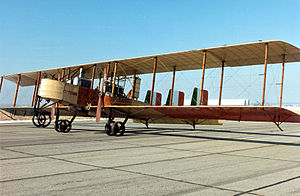Caproni Ca.36
| Caproni Ca.3 | |
|---|---|
 |
|
| Caproni Ca.36 at USAF Museum | |
| Role | Heavy bomber |
| Manufacturer | Caproni |
| First flight | 1916 |
The Caproni Ca.3 was an Italian heavy bomber of World War I and the postwar era. It was the definitive version of the series of aircraft that began with the Caproni Ca.1 in 1914.
The Ca.3 was a three-engined biplane of wooden construction, with a fabric-covered frame. The crew of four were placed in an open central nacelle (front gunner, two pilots and rear gunner-mechanic). The rear gunner manned upper machine guns, standing upon the central engine in a protective "cage" in front of a propeller. The fixed conventional undercarriage had double mainwheels under each engine and a tailskid under the extreme tail of each boom. A substantial double nosewheel prevented damaging and dangerous noseovers.
Armament consisted of two to four Revelli 6.5 mm or 7.7 mm machine guns, one in a front ring mount and one, two or sometimes even three in an upper ring mount. Bombs were suspended under the hull.
The development of the Ca.1 to the Ca.2 suggested the benefits of increasing amounts of power to the very sound airframe. The Ca.3 was a development of Ca.2, by replacing the two engines mounted on the booms with the same Isotta-Fraschini engine that had been used as the central, pusher engine on that design.
The prototype flew in late 1916 and was soon put into production. Known by Caproni at the time as the Caproni 450 hp, the Italian Army designated it the Ca.3. In Caproni's postwar redesignation, it became the Ca.33. Between 250 and 300 of these aircraft were built, supplying the Italian Army and Navy (the latter using the type as a torpedo bomber), and the French Army. Late in the war, Robert Esnault-Pelterie built the type under licence in France, building an additional 83 (some sources say only 19) aircraft.
Note: there is some variation in published sources over early Caproni designations. The confusion stems, in part, from three separate schemes used to designate these aircraft - Caproni's in-house designations of the time, those used by the Italian Army, and designations created after the war by Caproni to refer to past designs.
...
Wikipedia
